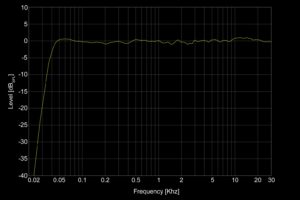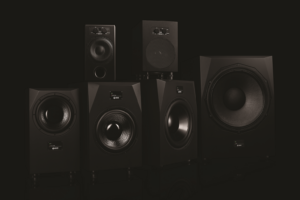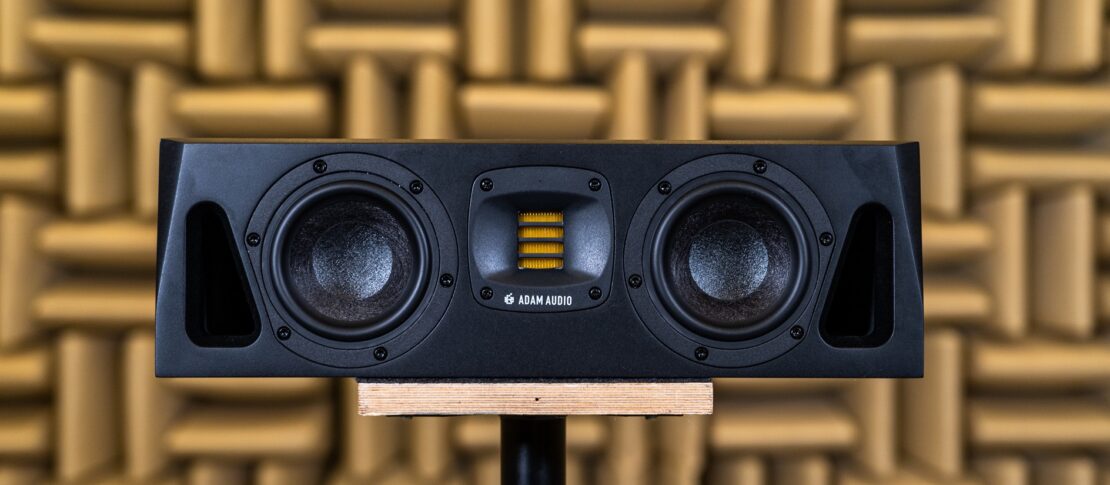
What’s The Story With Multiple Drivers? [Part 1]
Apart from a very few products designed for particular niche roles, pretty much all studio monitors, including all those that carry an ADAM Audio logo, have two or more drivers. But have you ever stopped to wonder why? Why is it that any monitor aspiring to reproduce high performance and accurate audio needs at least two drivers? In this blog post we’re heading back to first principles of speaker design to answer that very question.
The first hint of an answer to the “why multiple drivers?” question can be found in the enormously wide frequency range of human hearing. It’s generally accepted that we can hear frequencies from around 20 Hz (see Note 1) at the end of this article) at the low bass end of the range to 20,000 Hz at the high treble end (see Note 2)). In musical terms, 20 Hz to 20 kHz is about ten octaves (20 Hz, 40 Hz, 80 Hz, 160 Hz, 320 Hz, and so on), but perhaps a better illustration of just how wide is the range comes from considering the change in wavelength it covers. Wavelength quantifies the other side of the frequency domain. It’s the physical distance between wave peaks in a specified medium (like air), rather than a measure of the time between them.
Converting frequency to wavelength is done via a simple equation: wavelength ƛ equals speed of sound c divided by frequency f (ƛ = c/f), and if we do that sum for 20 Hz, using the generally accepted speed of sound of 343 meters/second, we get a wavelength of 17.15 meters (about the length of an adult fin whale). But if we do the same sum for the other end of the audible frequency range, we get a wavelength at 20 kHz of 1.715 centimeters (about the length of a big toe). So, a studio monitor is required to accurately generate acoustic energy with wavelengths from 17 m to 1.7 cm, and all those between, often simultaneously. There’re fundamentally three reasons why that’s all but impossible to do with any fidelity using just one speaker driver. The first is mechanical.
A driver works by its diaphragm accelerating backwards and forwards in response to the music signal and creating waves of alternating pressure in the air. The pressure waves are what we perceive as sound. But acceleration of the driver diaphragm results in mechanical stress, and there comes a point where the stress exceeds the diaphragm’s physical strength. Imagine taking a sheet of thin cardboard and waving it in the air. As you wave the card faster there comes a point where it bends, and that’s exactly what happens to a driver diaphragm. So while at low frequencies a driver diaphragm can withstand the acceleration and remain intact, at higher frequencies it stops moving as a whole and enters a mode that speaker engineers call ‘break-up’. In break-up mode, different parts of the diaphragm will be moving independently of each other, and the potential results are flaws in the frequency response and inaccuracies in the sound, i.e. increased distortion (see Note 3)).
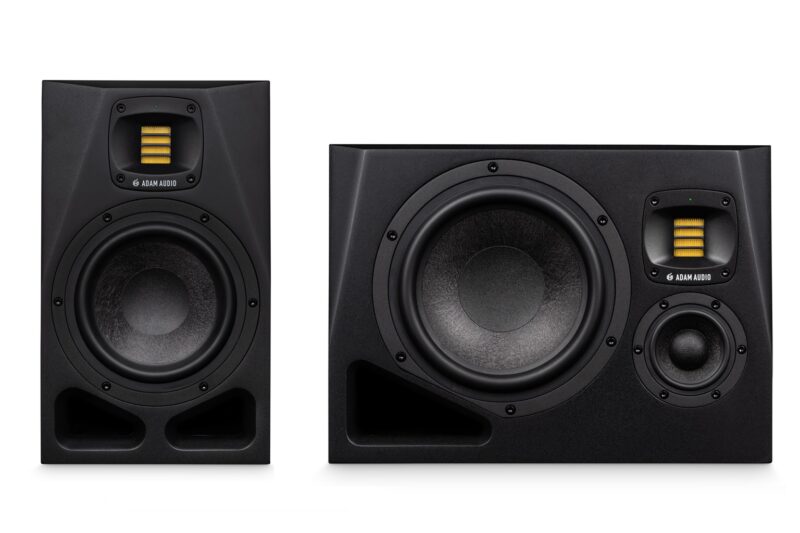
The A7V (2-way design) and the A8H (3-way design) studio monitors side by side.
The second reason one driver can’t cover the full audio band is related to the first, because you might imagine that one way of making a driver diaphragm stronger, so that it can accelerate more quickly without losing mechanical integrity, is to make it smaller. And you’d be correct. The problem is however that the volume of air a driver has to move in order to create audible acoustic energy increases inversely with frequency. One way of visualizing this is to consider how much air is present between the wavelength peaks at different frequencies. At high frequencies, where the peaks are only a few centimeters apart, there’s not much air volume between them, so a driver radiating high frequency energy isn’t required to move much air to generate audible sound energy. Its diaphragm consequently can be small. But at low frequencies, where the wavelength is so much greater, the volume of air between the wavelength peaks is enormous, so the driver has to move a huge volume of air to generate that same level of audible sound energy. So, there’s pretty much no alternative to bass driver diaphragms being large.
But what if we invented a material so strong (and light) that a diaphragm large enough to reproduce low frequencies could also accelerate all the way to 20 kHz without losing its mechanical integrity? Well, ignoring for a moment that the invention of such a material would probably win us a Nobel prize, completely revolutionize the world of engineering, and make us billionaires in the process, there’s still a problem: directivity, which is the third reason why a single driver isn’t enough. When a driver diaphragm vibrates to generate acoustic energy, if it is smaller than the radiated wavelength, the energy will propagate equally in all directions. But as frequency increases towards the point where the radiated wavelength is roughly comparable to the size of the diaphragm, the acoustic energy becomes increasingly directional; it will begin to radiate forwards in a beam. And the higher the frequency, the tighter the beam (which partly explains why tweeters are small). So a large diaphragm made from our magic material would be completely useless as a full-range driver because, if we were to move away from its central axis, the high frequency radiation would become close to inaudible.
So any speaker that aims to reproduce wide bandwidth audio with the kind accuracy necessary to claim the status of “monitor” needs at least two drivers; a large woofer for low and midrange frequencies, and a smaller tweeter for high frequencies. Typically, the frequency at which one hands over to the other will be somewhere between 2 kHz and 3 kHz. Some monitors take things further however and divide the full audio band into more segments to create three-way (the ADAM Audio A8H, for example) or even four-way systems (the ADAM Audio S6X main monitor), and in a future blog post we’ll describe some of the engineering and acoustic factors that drive monitor designers to decide between two-way, three-way or even more-way solutions.
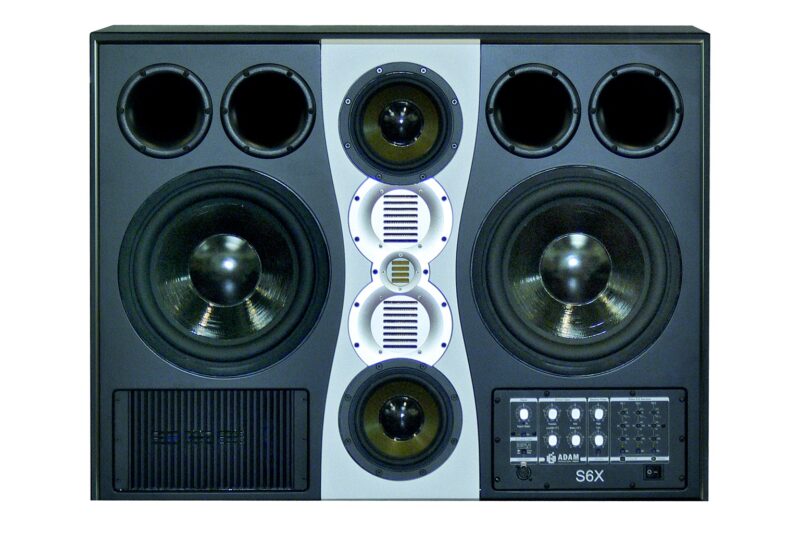
The S6X main monitor featuring a 4-way “D’Appolito” design.
Notes:
Note 1): The “Hz” symbol stands for Hertz. Not the well-known car rental firm but a measure, named after German physicist Heinrich Rudolf Hertz, of how many times an acoustic or electrical signal repeats itself every second.
Note 2): The 20 kHz upper limit of human hearing applies to youngsters only. As we get older, we progressively loose hearing sensitivity in the top octave, so that by the time we’re around sixty, frequencies above 10 kHz or so become significantly attenuated. Luckily, the brain is incredibly good at adapting to age related hearing loss, so just because somebody is into their seventh decade, it doesn’t mean that they can no longer appreciate high frequencies. It’s also of course the case that most important musical information resides below 10 kHz.
Note 3): A driver diaphragm working in break-up mode isn’t always entirely bad news. Break-up can, in fact, be engineered to help extend the operational bandwidth of a driver. We’ll describe how that works in the promised future blog post.
